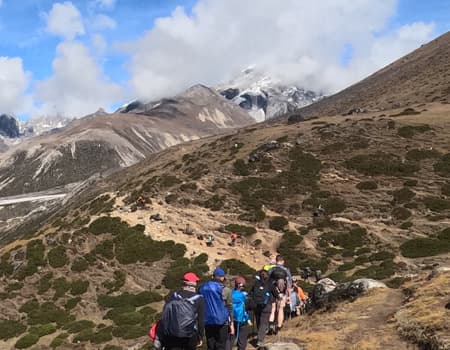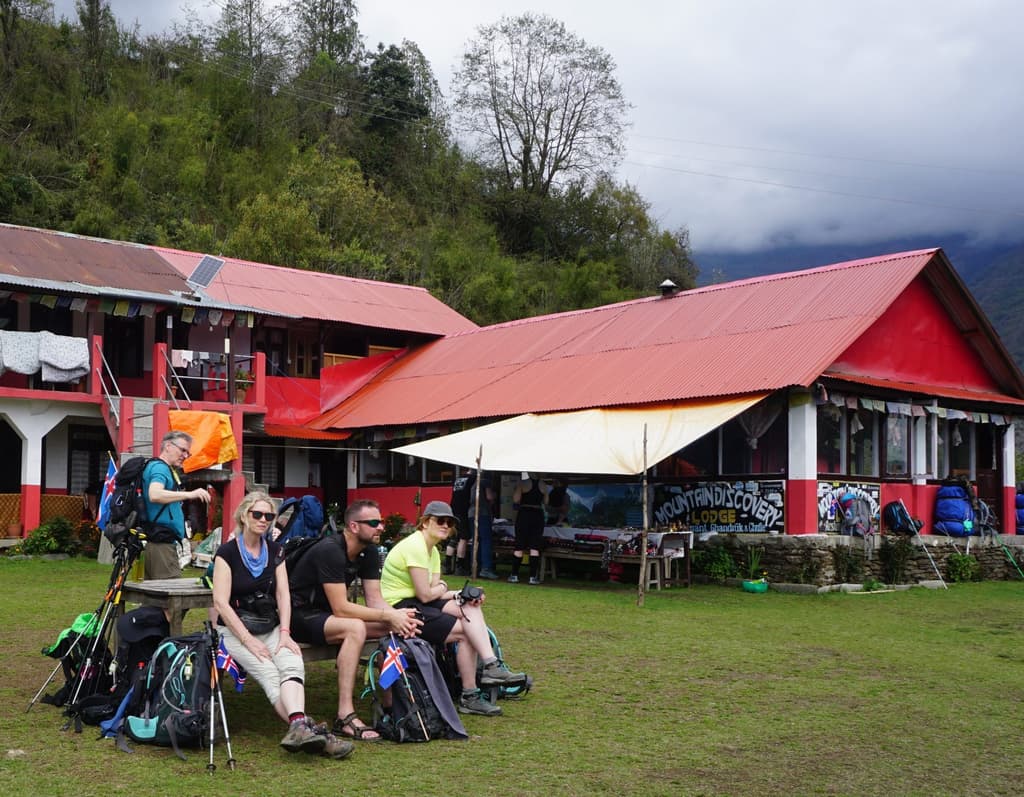Climate change has a profound effect on trekking in Nepal, bringing about notable consequences. The melting glaciers, erratic weather patterns, and heightened risks of avalanches present substantial challenges and hazards for trekkers. Additionally, the shifting climate disrupts the natural surroundings, impacting landscapes, flora, and fauna, thereby potentially compromising the overall trekking experience. Considering these factors is crucial when preparing for a trek in Nepal, as they have a direct impact on the safety and enjoyment of the journey.
Climate change is one of the most pressing issues faced by our planet today, and its impacts are being felt in every corner of the globe. Most importantly, the significant effect of trekking that many lack seeing. Trekking, a beloved pastime for many outdoor enthusiasts, is no exception. Climate change at it began slowly. But realizing the difference is so vast; it’s almost too late. If not now, it seems this will end this fun outdoors.
Glaciers in mountain regions such as the Himalayas melt alarmingly as global temperatures rise. This affects these areas’ natural beauty and ecosystem and poses a significant threat to trekkers. The melting of glaciers can also cause water shortages in local communities that rely on glacial melt for their drinking and irrigation needs. This can lead to resource conflicts and make it difficult for trekkers to find potable water along their routes.
The temperature rise has resulted in incidents like weather pattern shifts; trekkers are facing new challenges and hazards. Moreover, these changes are occurring so rapidly that it is hard to ignore them now. The glacier retreat is leaving behind treacherous lakes and unstable moraines.
For trekkers and hikers, this has been a great pain; they must navigate through these new hazards to reach popular trekking destinations such as Everest Base Camp and Annapurna Base Camp.
Here are ten ways in which the impact of Climate Change is seen when it comes to trekking.
Increased landslides and flooding
The temperature rise has caused problems like heavy rains causing the monsoons to be more violent and frequent. Thus, making some trekking routes complex and dangerous to trek on. The risk of flash floods and rockfalls is too significant to ignore. Therefore, Tourism comes to a total halt around that season.
Thus, trekkers must be prepared for these hazards and plan their routes accordingly. Ultimately, this makes the route harder and riskier, giving the trekkers second thoughts on whether they should trek this region.
Glacial Retreat
The Impact of Climate change can be seen from this perspective much better and clearly. The glaciers in the Himalayas are retreating at an alarming rate. When talking about Nepal (one of the best spots for trekking). The great Himalayas experience very little snowfall around the mid-winter.
The glacial retreat is affecting the water supply for millions of people and creating new hazards and challenges for trekkers. When they retreat, the glaciers leave behind treacherous lakes and unstable moraines.
These create a significant risk than any of us can ever imagine. Melting glaciers can also cause changes in the water flow of rivers and streams, making it more difficult to cross them. As glaciers melt, they release large amounts of water, which can cause rivers and streams to swell, making them more challenging to cross. This can make specific trekking routes impassable or at least more difficult and dangerous.
Thus, to trek around such hazards, trekkers now have to navigate their best to reach the site. As glaciers melt, trekkers face new risks such as flash floods and rockfalls.
Melting glaciers can also cause changes in the water flow of rivers and streams, making it more difficult to cross them. As glaciers melt, they release large amounts of water, which can cause rivers and streams to swell, making them more challenging to cross. This can make specific trekking routes impassable or at least more difficult and dangerous.
Reduced Snow Cover
The rising temperature of the earth has also been causing the snow cover in the mountains to melt fast. Even around mid-winter, there is no snowfall around the Himalayas.
The fun of trekking the Himalayas, a trail covered with snow, is slowly turning into a myth with less to no snowfall around these regions. Some trekking routes previously covered in snow are now rocky and challenging to navigate. Thus, trekkers must be prepared with appropriate gear for different terrains for such encounters.
Changes in Vegetation and Wildlife
Another signification change that we can see is when it comes to vegetation around the mountains. The trekkers may find new types of plants and vegetation, and also, for people staying around those areas.
The cultivation of plants and vegetation may not remain the same as it used to be. It has a direct impact on animals around there. Moreover, species are shifting their ranges, and some are becoming increasingly rare. The lifestyle is slowly changing, and we are failing to notice it.
Increasing Frequency and Severity of Extreme Weather Events
Climate change is causing weather patterns to shift drastically. Winter lasts too short when it is compared to summer. Trekkers now face another challenge to predicting the weather while on a trek. They must be prepared for a drastic change in temperature and have appropriate gear and clothing to stay warm and safe. The risk of floods, landslides, and wildfires is increasing. These events can make trekking routes impassable and put trekkers in danger.
The Rise in Altitude Sickness
As temperatures rise, the air becomes thinner, making it harder for trekkers to acclimatize to high altitudes. This increases altitude sickness, which can be dangerous if not treated properly. Moreover, the warmness of the earth also has caused other life-endanger diseases to prevail around the trails. Diseases like dengue fever and malaria
Are at a great rate in such paths. Thus, trekkers must prepare for yet another challenge.
Reduced Access to Clean Water
We just realized how fast the glaciers are melting. This ultimately means that water sources are becoming scarce. Their primary source is the glaciers; how can we expect to get water if the source isn’t there?
As glaciers melt and rainfall patterns change, many trekking regions face water shortages and increased water pollution. Trekkers must plan for longer stretches without water and carry more water throughout trekking spots.
Rising Temperatures
One of the most obvious ways in which the Impact of Climate Change has its effect on trekking is through rising temperatures. Trekkers face more heat collapse, dehydration, and sunstroke as the planet warms.
This is especially true in low-lying areas and at a lower height, where temperatures are already relatively high. Also, the rising temperature creates a situation where the Himalayas don’t get the proper amount of snowfall, even during the peak season. Lacking to keep the vibes of trekking the fierce Himalayas.
Increased Human Impact And Loss of Cultural Heritage
The impact of Climate Change is becoming more pronounced. Thus, more and more people visit the mountains to see the change themselves. Some even trek these regions, thinking these great spots may go extinct someday. This increased human traffic is hurting the fragile mountain environment. Trekkers now must be aware of the impact that they are having and take every step with great care to minimize it.
Climate change is also impacting the cultural heritage of many trekking regions. As glaciers melt and extreme weather events become more frequent, traditional trekking routes and cultural sites are lost.
Changing Local Economies And Cultural Heritage
The local economies are direct hit by the impact of Climate Change as the condition worsens at such high altitudes. These sites get more risker to trek. And guess what? Few people are visiting the mountains, the people who depend on tourism as their primary source. This is a pure checkmate. Thus, the local economy and the profession of the people who rely on trekkers are getting a great hit.
Climate change also affects the cultural heritage in many trekking regions. Melting glaciers and the increased frequency of extreme weather events are causing the loss of traditional trekking routes and cultural sites.
To summarize, something we heard ever since we were kids is slowing now being the reason everything is at risk, the whole planet itself. If we still take this issue lightly, the end is inevitable.
As a responsible trekker, it is also essential to consider the trip’s carbon footprint and offset it by supporting carbon offset projects by being aware of these impacts and taking appropriate actions.
From rising temperatures and melting glaciers to economic impacts on local communities and planning difficulties, these impacts make trekking more complex and less predictable.
We must take action to reduce our greenhouse gas emissions and help communities adapt to the changes that are already happening. This will help ensure that trekking will remain a viable and enjoyable activity for generations.
As trekkers, we must be aware of these issues and take steps to minimize our environmental impact.
This can include choosing eco-friendly trekking companies, supporting local conservation efforts, and being mindful of our water and energy usage while on the trail. It is also essential to support policies that address the root cause of climate change, such as reducing carbon emissions and protecting vulnerable ecosystems.
By taking these actions, we can work to preserve the natural beauty and cultural heritage of mountain regions for future generations to enjoy.



Post a Comment